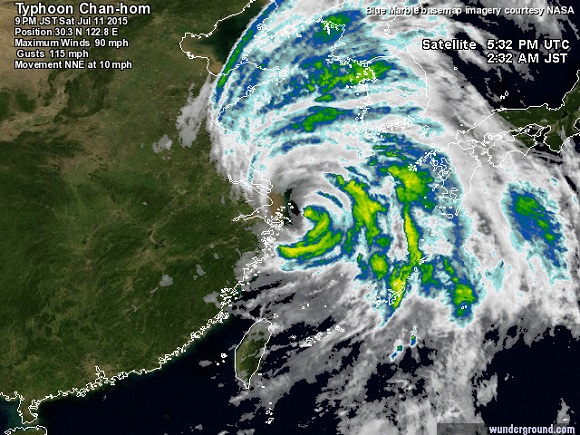Typhoon Chan-hom
Status: Closed
| Type of posting | Posting date(EST): | Summary | Downloads |
|---|---|---|---|
| Post Landfall 1 | 7/15/2015 2:00:00 PM |
|
|
| Landfall | 7/13/2015 1:00:00 PM |
|
|
| Pre-Landfall 2 | 7/10/2015 1:15:00 PM |
|
|
| Pre-Landfall 1 | 7/8/2015 2:00:00 PM |
|
Landfall | Summary
Posting Date: July 13, 2015, 1:00:00 PM
Summary
One of the most powerful typhoons to hit eastern China this year made landfall at 4:40 p.m. local time on July 11 in Zhoushan city. Coastal Zhoushan is about 130 km south-southeast of Shanghai, across Hangzhou Bay. Maximum sustained winds at the time of landfall reached 45 m/s, qualifying Chan-hom as a Category 2 storm, although Chan-hom reached its highest intensity of 935 mb (Category 5) just 24 hours prior. Winds in the city of Shanghai were not very strong; the airport reported wind speeds of sustained 64 km/h, gusts to 90 km/h. After landfall, the storm quickly veered back out to sea. Some reports suggest this could be the strongest July typhoon to hit Zhejiang since 1949.
Significantly cooler sea surface temperatures off the coast of China caused the storm to rapidly weaken as it recurved out to sea. Chan-hom made landfall in North Korea on July 12 at approximately 3 a.m. local time as a tropical depression with sustained wind speeds between 80 km/h and 88 km/h.
Reported Impacts
More than 1,000 houses are reported to have collapsed in China. Industries most impacted include agriculture, with reports of more than 200,000 hectares affected by Chan-hom, and transportation, after thousands of flights and trains were canceled due to weather conditions. The storm affected 2.8 million people in 520 villages and towns, spanning 69 counties and nine cities of Zhejiang Province.
According to official estimates released today by the Zhejiang government, economic losses in the province are estimated at CNY 8.44 billion. Insured losses will be significantly lower.
Heavy downpours were reported in some areas, including Shanghai and the provinces of Anhui and Fujian, flooding roads and fields. The China Meteorological Administration (CMA) reported close to 40 cm of precipitation in the city of Lai'ao Village in Sanmen County south of Shanghai. Reports of major coastal flooding are beginning to surface.
Evacuations prior to landfall included about 1.2 million people from coastal areas of Zhejiang and more than 56,000 in neighboring Jiangsu. Preparations also included ordering the entire fishing fleet back to port. Power and telecommunications were interrupted. Because Shanghai was on the weak side of the storm system, however, the metropolis did not see much wind damage.

Figure 1. Satellite image of Typhoon Chan-hom at landfall in Zhoushan.
(SOURCE: Weather Underground)